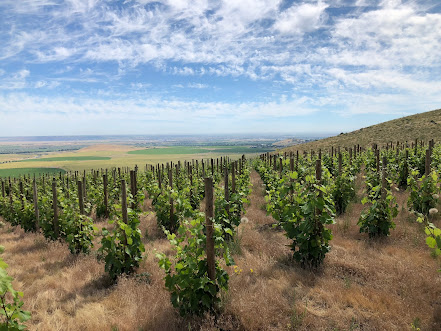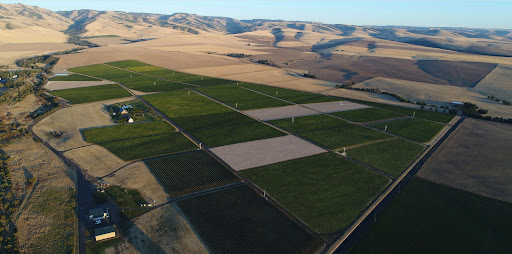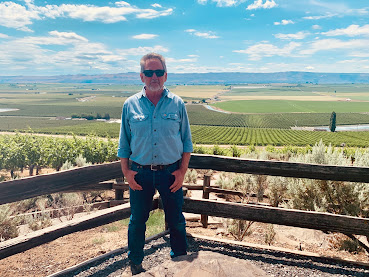Put hand selected clones in nano-planted blocks at higher elevation on Red Mountain, often at high density and sometimes with northern aspects. Use this and a variety of trellising techniques to achieve longer hang times and wines with more intensity, freshness, and non-fruit characteristics. Farm it all with a maniacal level of attention and try and make wines that elevate the notion of what is possible in Washington.
The earliest look at wines from this property came from Liminal Wines, a project from Marty Taucher and Chris Peterson (Avennia) that I wrote about back in 2020. For their inaugural releases, Liminal was my 2020 Winery of the Year.
Now comes a series of 2019 estate red wines from WeatherEye that were just offered last week. These wines were crafted by Todd Alexander (Force Majeure, The Walls, Páxša, and Holocene). They are quite simply some of the best wines I’ve ever had from Washington.
“We started with a really interesting piece of property and a belief that we could try and make something great,” says Cam Myhrvold, who began purchasing land for what is now WeatherEye Vineyards back in 2004. “The plan was always to start as a vineyard, and if the fruit was really great and unique, then we’d follow that up with an estate wine project.”
It is hard to describe the extreme level of effort and detail that has gone into this vineyard without seeing it. There are currently 33 acres planted, with about 29.5 of them in production. None of the blocks could have been easy to plant. Some of them are on quite steep terrain. The soil often has a significant amount of fractured basalt. The vines must be hand tended and harvested. Most of the blocks are minute in size, tightly matched to the terrain.
“We feel like what we're doing on the vineyard side is some pretty innovative stuff,” says vineyard manager Ryan Johnson, who designed and planted the site.
Johnson, who has more than 20 years of experience on Red Mountain, spent six months just walking the ground before planting to try and fully understand the aspects, soils, and wind patterns. In the end, he attempted to match clone and variety to trellising technique and location with an intensive level of detail.
“So much of this was kind of an experiment,” Johnson says. “It's a confirmation that terroir is important, viticulture is important, and so is the clonal material that we use.”
WeatherEye currently works with 10 hand-selected wineries, with many more clamoring to access the fruit. The choice of Alexander to craft the estate wines was both inspired and an easy one. Johnson had been working on the nearby Force Majeure project but was ending his tenure right as Alexander was starting at that winery.
“He's a top tier winemaker, making wines at the highest level,” Johnson says of Alexander. “I think there was this mutual drive to be able to work together at some point.”
Meanwhile Alexander’s interest in working with WeatherEye fruit only increased as he saw the vineyard come to fruition. “It's an incredible amount of work, and a lot of thought has gone into it,” he says of the site.
The first WeatherEye estate wines were made in 2018, with a Syrah and Grenache at a mere 140 total cases. That expanded to a still-meager 400 cases in 2019. The 2020 production will be double that, with white wines added to the program.
Below is a description of the 2019 releases from the eyes of the people who helped create them. My scores for these wines from my time at Wine Enthusiast are at the bottom of the article.
WeatherEye Estate Grenache Red Mountain 2019
“This is really a unique mesoclimate,” Johnson says of the spot these vines are planted. “It's a little, sandy basalt outcrop. The way that outcropping works is it almost acts as its own wind shelter. You have these screaming winds hit the upper slopes of Red Mountain, and it'll go right over the top of this block.”
The entire block, which is called ‘La Mesita,’ is 0.3 acres, planted at a high density of 3,200 vines per acre. The vines are planted using a goblet training system.
“The soils really thin out just to the north of [the block],” Johnson says. “That's why it's 0.3 acres. We certainly use every last little square foot.”
WeatherEye Estate Syrah Red Mountain 2019
The 2019 Syrah is a blend of two different blocks. One is composed of the highest vines planted on Red Mountain at an elevation of 1,230 feet. The other block is planted meter by meter sur echalas – on stakes.
“It's got the highest elevation vines but also the highest vine density,” Johnson says. “It’s just a match made in heaven.”
One of the blocks is on the northeast side, which is unusual for Washington. The other is southwest facing. The blocks are 0.5 and 0.4 acres in size.
“Those are picked separately and vinified separately, and then we put a blend together at the end,” Alexander says.
WeatherEye Estate Mourvèdre Red Mountain 2019
Mourvèdre is only planted in miniscule amounts on Red Mountain – eight total acres as of the 2017 state acreage survey, the most recent that was conducted. The block this wine came from won’t tip the scales, as it is only 0.9 acres.
The block is located along the ridgeline of Red Mountain at an elevation of 1,200 feet, where the soils are fractured basalt. The vines are planted as bush vines.
“The Mourvèdre has been a real eye opener,” Johnson says. “Our approach to viticulture is we want to express the savory notes, the non-fruit elements, and I think we hit it with [this wine].”
WeatherEye Estate Tempranillo Red Mountain 2019
The 2019 Tempranillo also comes from vines planted on the north side of the mountain. Johnson says he treats the Tempranillo viticulturally like he does Syrah.
“It’s sur echalas training, high density,” he says. Johnson gives a descriptive take on the inaugural vintage.
“The Tempranillo is like sucking on the Grim Reaper's cloak. It's dark, it's slightly dangerous, and it's mysterious. I opened that the other night, and it just grabbed hold of my psyche. It was really one of those intellectually stimulating wines because it's not what you think it would be.”
The final red wine from 2019 is the Hillfighter, a blend made from declassified barrels that will change from year to year. It’s one of those “If this is what the declassified stuff tastes like, I’ve got to try the other wines” bottles. Of note, all of the label images were taken by Ryan Johnson.
* * *
Red Mountain has long been dominated by red grape varieties, which make up 96% of the appellation’s acreage. Alexander, however, is bullish on the prospects for whites at WeatherEye, which includes acreage that spans beyond the appellation’s boundaries.
“I think the potential for Rhône whites is really, really high,” he says. “You get nice juicy grapes without a lot of phenolics. You get just the right amount of texture. The acid stays gorgeous. The sugars are in check. They’re just really, really beautifully balanced.”
We will see what the future holds for white wines at this vineyard. However, the 2019 WeatherEye red wines and those that come after them will surely change the calculus of Washington wine. These are wines that will capture the imagination of consumers and critics alike. (See a recent writeup on the vineyard from Alder Yarrow at Vinography for an example of the attention this site and its wines are already receiving.) They show the heights that are possible with an extreme focus on site selection and farming.
Is what Myhrvold and Johnson are doing at WeatherEye easily extendable to other areas of the state? Extendable, perhaps. Easily? Certainly not. A project like this takes an extraordinary amount of time and a truly fanatical level of dedication.
“Ryan's probably the most obsessive farmer I've known,” Alexander says. “His attention to detail is really, really high.”
“It's exhausting. It’s exciting,” Johnson says of the vineyard. “It’s all I think about honestly in my spare time, searching out new information, rethinking different blocks. I mean, it might border on a sickness really, right? But I wouldn't want to do anything else.”
An additional part of what makes the initial releases from WeatherEye, Liminal, and others from this site so remarkable is that these wines are coming from young vine fruit, albeit from very strong vintages. It’s hard to imagine how high the potential is as the vines age, the site stretches its legs, and vintners fully learn how to work with the fruit.
“Right now, it’s a young vineyard where you're pulling stuff that no one's ever worked with before,” Alexander says. “There's really no track record on anything.”
To give a sense of the overall commitment, Myhrvold is now 18 years into this project. It’s only in the last few that he’s started to see the first fruits of his investment. Still, for all the time and money, he says it’s been a rewarding journey.
“Everything takes a long time,” Myhrvold says of the wine industry. “But if I stand back and look at it objectively, I have to be pretty pleased at where we are and what I think we can do in the future.”
WeatherEye 2019 Estate Grenache Red Mountain $85 96 points
WeatherEye 2019 Estate Syrah Red Mountain $85 96 points
WeatherEye 2019 Estate Mourvèdre Red Mountain $85 95 points
WeatherEye 2019 Estate Tempranillo Red Mountain $85 92 points
WeatherEye 2019 Hillfighter Red Blend Red Mountain $55 92 points
Images courtesy of WeatherEye Vineyards.

































%20and%20Jesse%20Schmidt%20Matthews%20Winery.jpg)


